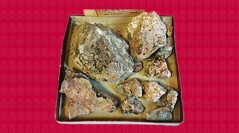

 Geodiversitas
44 (8) - Pages 237-263
Geodiversitas
44 (8) - Pages 237-263The present study focuses on the analysis of an unpublished assemblage of microvertebrate remains recovered in 1910 at Ben Kerat, northeastern Algeria. The main aim of this study is to evaluate its palaeontological potential, and to clarify its geological and chronological contexts. The studied assemblage obtained from several chunks of breccia comprises 362 identified remains belonging to 44 individuals and 11 taxa: six rodents belonging to the genera Gerbillus Desmarest, 1804, Meriones Illiger, 1811, Paraethomys Petter, 1968, Mus Linnaeus, 1758, Praomys Thomas, 1915 and Ellobius Fischer, 1814, two soricids of the genus Crocidura Wagler, 1832, one anuran, one lacertid lizard and one colubrid snake, that indicate a correlation to the end of the Middle Pleistocene. Although the overall faunal spectrum is similar to other assemblages from North African sites of Middle Pleistocene age, the Ben Kerat specimens display particular dental patterns, which may reflect either a period of climatic amelioration in a more global context of increasing aridification and cooling, or a regional particularity with, notably, new forms of Paraethomys and Mus that do not fit into the evolutionary lineages known thus far in North Africa.
Rodents, soricomorphs, squamates, amphibians, Middle Pleistocene, northeastern Algeria, new species